Despite implementing traditional CRO techniques, many marketers hit conversion plateaus that are difficult to break through.
One clear example of this is A/B testing. Marketers are known to be great at A/B testing, but gains often disappear after the last variant is tried. AI can step in here to fill in the blanks by automatically sending visitors to the creatives that are doing the best, customizing the experience for each visitor in real time, or even changing prices on the fly. This turns the “test-and-wait” cycle into an engine that is always improving.
This article’s goal is to equip you with practical tactics and tools for AI-driven CROs that deliver precise, measurable results. By the end of this article, you will understand which AI CRO tools best match your needs and how to implement them for measurable conversion gains.
How Businesses are Using AI to Boost Conversion Rates
There are three primary AI flavors in CRO:
- Predictive AI: this forecasts user behavior and conversion likelihoods.
- Generative AI: produces content variations (such as copy, images, or layouts) tuned for higher engagement.
- Prescriptive AI: which recommends concrete actions you can take that are most likely to raise conversions.
The best way to approach AI in business is to think of it as an “always-on assistant” who handles the heavy data crunching so that website owners and marketers can focus on strategy and creativity. This makes solutions like PageSpike’s analytics, for example, feel empowering rather than overwhelming.
Why does it matter, though? Consider that the average ecommerce site still converts 1.8% of visits, so even single-digit lifts have outsized revenue impact. AI Max for Search, however, is already driving +27% conversions at the same CPA.
As an example of how prescriptive AI can impact store goals, Performance Max’s bid-and-asset recommendations helped L’Oréal Paris hit omnichannel targets, delivering over 5× more conversions while cutting cost-per-acquisition by 49%.
Real-time micro-personalization can also be applied: an AI layer monitors each visitor’s scroll depth, dwell time and referrer, then instantaneously tweaks headlines, hero images, or button copy to mirror their intent, thereby cutting bounce risks and pushing them further down into the funnel.
The dynamic incentive engine is another impactful strategy. If behavioural signals (e.g., copying prices for the third time or cart hovering) start tracking signs of hesitation, AI deploys the lightest nudge necessary, such as a free shipping banner, limited-time discount, or loyalty points, depending on the shopper’s likelihood to convert and margin guardrails for the merchant.
Top 5 AI CRO Tools
Here is a snapshot of how modern AI elevates CRO beyond one-off tests:
- Real-time traffic orchestration: algorithms shift visitors away from under-performing variants the moment the data says “no good,” so impressions aren’t wasted.
- On-the-fly micro-segmentation: patterns like “mobile-social users respond best to short video, search visitors to concise text” pop up automatically, and each segment is served its ideal asset.
- Intent-based routing: every click is matched to the landing page most likely to convert based on query, referrer, and past behavior; brands see lifts of roughly 18% from this alone.
The five featured tools sit at a continuum from beginner analytics to enterprise-grade personalization, where all of them enable you to find opportunities, make tweaks, and track gains; these themes set the stage for the five tools being unpacked next.
PageSpike – An AI Landing‑Page Analyzer
Think of this tool as your CRO co-pilot: it offers small-business convenience with enterprise-level insights about your landing pages. It runs a diagnosis for a page of your choosing, then provides you with a list of prioritized solutions and fixes to boost your conversions.
This AI landing-page analyzer gives web owners an easy on-ramp to AI-powered conversion optimization – and it’s easy to use: you simply paste in the URL and it comes back with recommendations based on a strict CRO criteria.
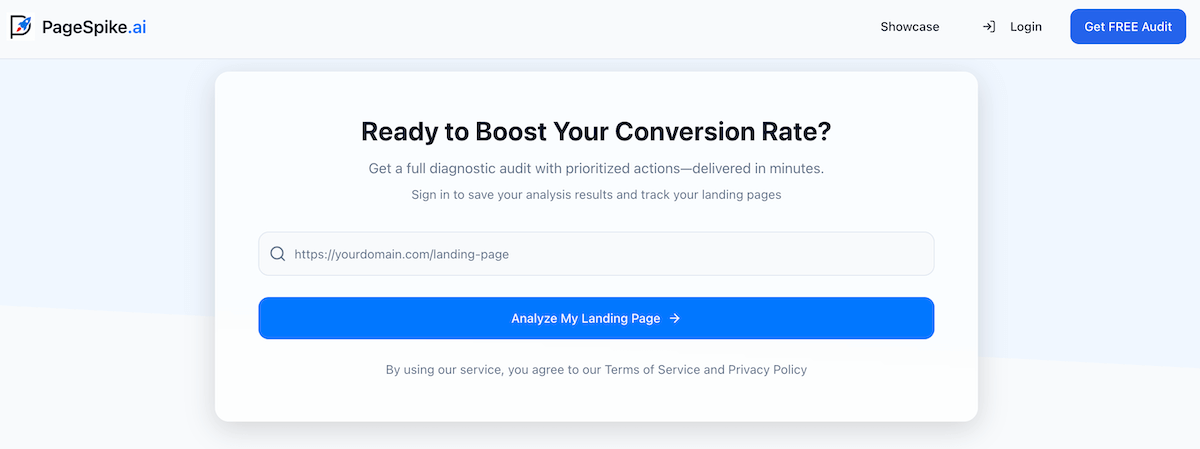
Some of the core criteria that are evaluated include:
- Hero Section engagement potential: headline structure, CTAs, social proof and layout are all assessed to ensure that your page makes a strong first impression.
- CTA visibility and optimal placement: the analysis looks at placement, visibility, and action-focused wording.
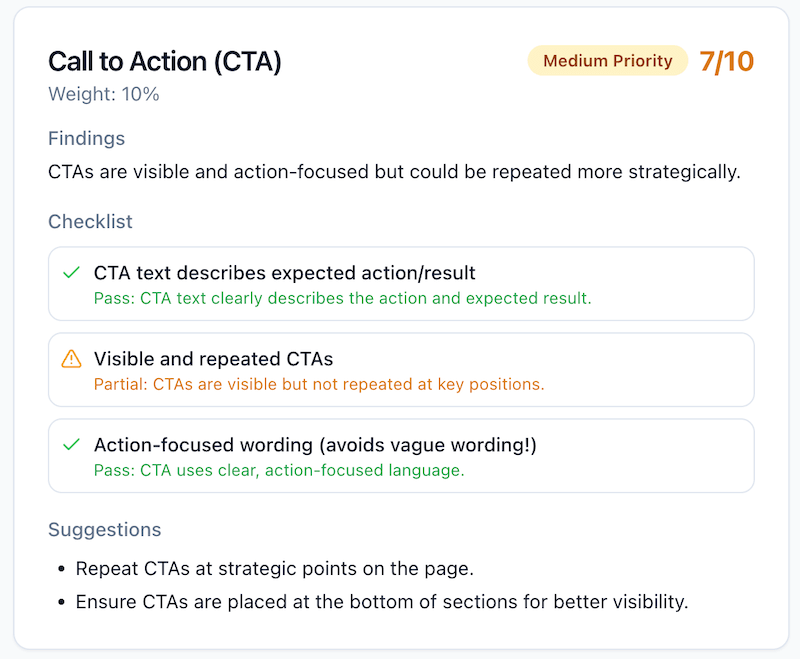
- Ease of Navigation: check that your navigation is simple and accessible.
- User Experience: Content readability, mobile responsiveness, page-load performance and overall UX are all tested.
- Essential landing page sections: The analyzer will also check for, and assess, core sections such as testimonials, social proof, benefits, FAQs and so on.
PageSpike follows up the analysis with detailed Next Steps recommendations and possible ideas for A/B testing. Once you have made changes, you can rerun tests and track your progress with the Analysis Score Trend.
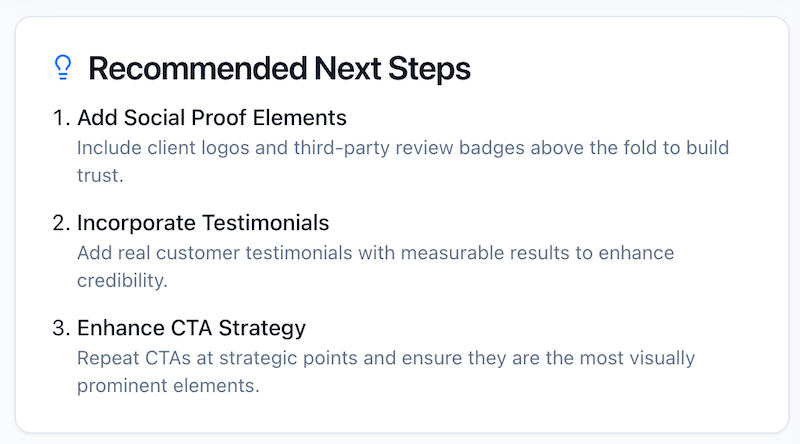
The tool runs on either a credit system or a monthly subscription, so you’re not tied into it long-term. Altogether, PageSpike’s landing page analyzer offers a risk-free springboard into AI-led optimization.
Pathmonk
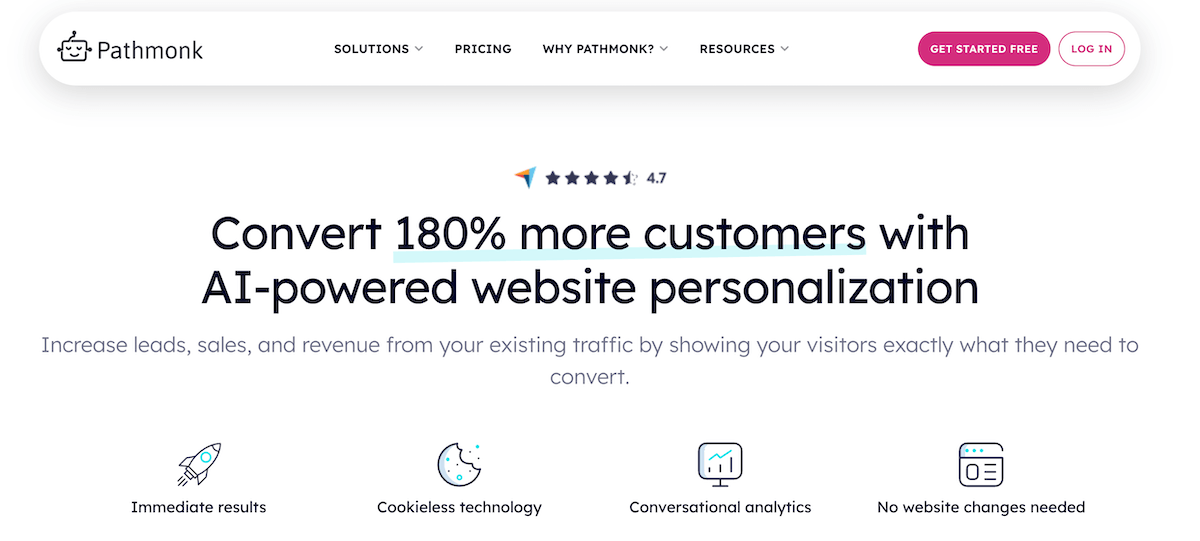
Pathmonk offers a cutting-edge solution for tracking visitor behavior without relying on cookies, enabling businesses to gain better behavioral insights that sidestep today’s privacy restrictions. Instead of using traditional tracking methods, Pathmonk leverages advanced machine-learning models to interpret a visitor’s “digital body language” in real time. This includes signals such as scroll depth, time spent on page, mouse movements, and clicks on specific elements, all of which can help the system accurately infer a visitor’s intent.
Once the intent is clear, the platform automatically displays the most persuasive content on the fly. For example, a prospective buyer in the research phase might be shown detailed product specifications, while a high-intent buyer could see a limited-time offer or a compelling call to action.
Pathmonk’s real strength lies in its ability to nurture leads intelligently across their decision journeys. It delivers exactly the right content at the right moment, smoothing complex funnels and accelerating conversions. Getting started is lightweight; drop in a JavaScript snippet, and the system usually begins showing measurable gains within two to four weeks.
Unbounce Smart Traffic
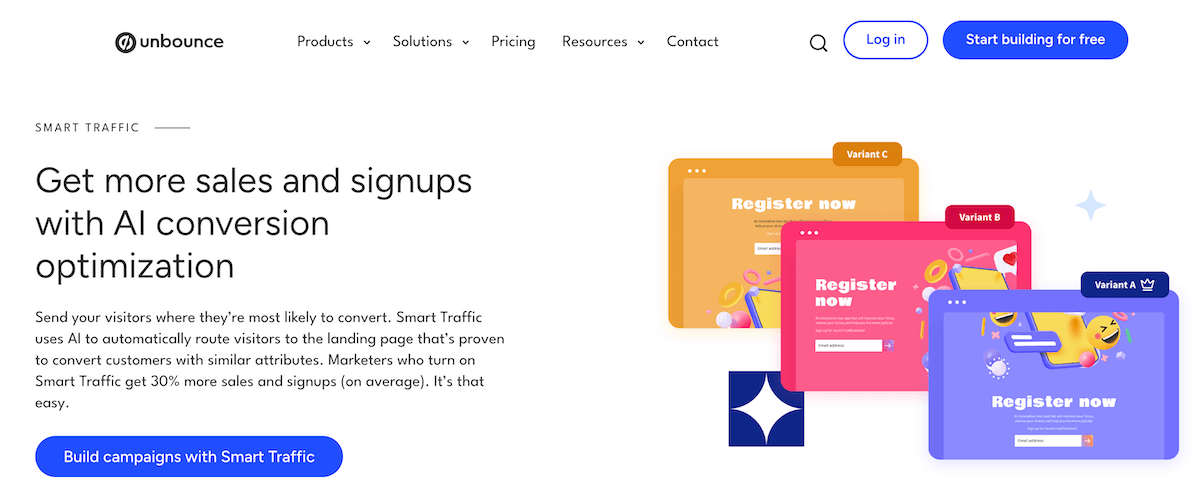
Unbounce’s Smart Traffic applies machine learning to send each visitor to the landing page variant most likely to convert based on their live attributes and behaviors. Unbounce says that this will provide marketers with 30% more signups and sales than average.
The platform starts optimizing in as few as 50 visits, sidestepping the long wait for statistical significance that traditional A/B tests demand. This also means faster insights and improvements, for quicker results.
Instead of waiting for statistical significance, Unbounce uses machine learning to constantly weigh key factors like referral source, device type, location, browser, and time of day in real time. These signals are continuously assessed to detect patterns that drive conversions.
You can create multiple landing pages and new visitors are then routed to the variant where similar profiles have already converted. This personalized approach replaces generic, one-size-fits-all experiences with tailored journeys that convert.
VWO Insights + SmartStats
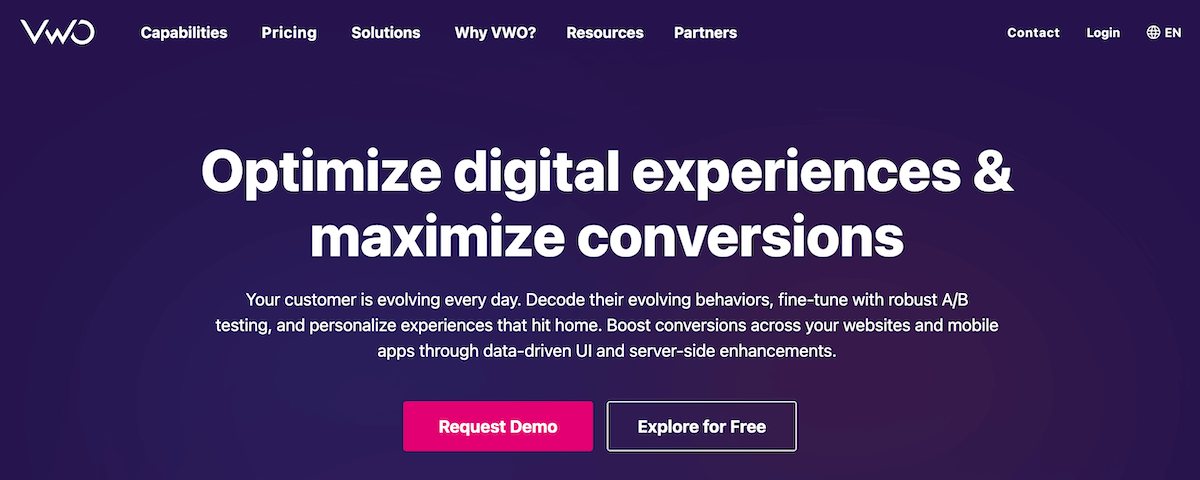
VWO combines qualitative insight tools, heatmaps, surveys, and session recordings with quantitative testing, along with an AI engine called SmartStats. Hooked up with VWO Testing, you can experiment end-to-end with visual tweaks on the site, mobile app flows, and even server-side logic and algorithms.
Deep segmentation reveals how each cohort responds; for example, a layout might increase new-visitor conversions but decrease the number of returning users. Based on recommendations, you can eliminate potential roadblocks to user experience and increase the likelihood of conversion.
The best fit is mid-market or enterprise teams that live and breathe CRO; there is a bit of a learning curve, but it is perfect for rigorous, data-driven programs. We would suggest using it when you need statistical rigor and granular cohort views.
Adobe Sensei (Adobe Target)
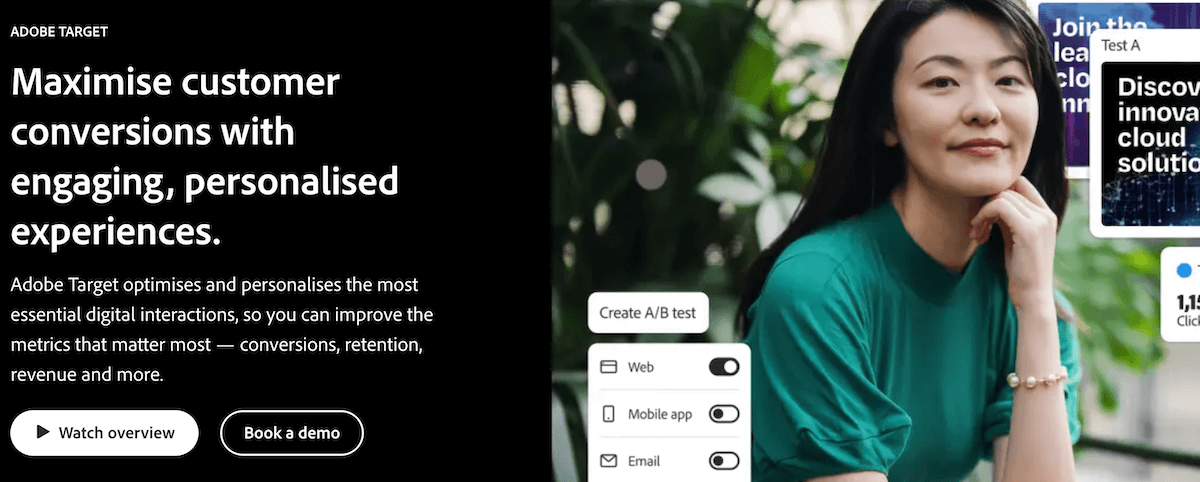
Adobe Sensei powers the AI capabilities within Adobe Target, enabling enterprises to test and personalize at a massive scale across every digital touchpoint. Seamless cross-channel personalization ensures consistent messaging as customers transition between web, email, mobile apps, and in-store screens, leveraging data from the full Adobe Experience Cloud.
All that power, however, comes with complexity: fully leveraging these platforms requires a substantial investment. Implementation often demands a significant budget, skilled technical teams, and dedicated resources to manage and maintain the system. Custom integrations, data configuration, and ongoing experimentation are not out-of-the-box processes – they require strategic planning and execution.
As such, Adobe Target is typically best suited for large enterprises with mature digital optimization programs already in place. However, for organizations with the infrastructure and expertise to support it, the potential return in personalization performance and increase in conversions can be substantial.
Do Small Sites Need AI for CRO?
For websites with modest traffic levels, the hurdles of traffic-based pricing and dev hours needed to implement AI can erase any conversion gains. The PageSpike landing page analyzer sidesteps the volume barrier, providing low-traffic sites with actionable page-level recommendations at a fraction of the cost of enterprise solutions.
Plenty of sites that run on WordPress don’t need custom integrations and enterprise-level AI tools to see significant CRO boosts. They have access to plenty of plugins that can do this job for them: FooConvert is one such plugin they can use.
Non-AI tools, such as FooConvert widgets, exit-intent popups, targeted offers, and countdown bars, deliver fast and measurable ROI without requiring heavy setup. FooConvert’s analytics also track the engagement data that larger AI engines will eventually require, laying a solid data foundation now. For increasing conversions, it is a simple and effective solution.
We recommend following a phased plan: start with basic analytics and high-impact widgets, add the PageSpike analysis as traffic climbs, and graduate to full AI platforms once consistent patterns and bottlenecks emerge.
Even if your store only attracts a few hundred visitors a month, PageSpike finds the single highest-impact fix that can be done today, usually in under ten minutes. It was designed to give bootstrapped teams an enterprise perspective on how they can boost CRO without the enterprise price tag, so AI begins reimbursing for itself from day one.
Brad Vincent, FooPlugins CEO and Developer
Start Your AI CRO Journey Today
If you’re looking for an AI tool that helps you optimize conversions, PageSpike is the ideal entry point – it has minimal setup, is reasonably priced, and offers immediate actionable insights. The analyzer identifies conversion bottlenecks by scanning layout, speed, and CTA placement.
Implementation is simple: run the analyzer, fix the highest-impact issues first, and measure results.
For WordPress users seeking immediate improvements, FooConvert widgets work as a complementary tool for quick wins. With FooConvert, you can implement CTAs, signups, and other conversion elements, followed by analysis to maximize the impact these have.
Run your free AI landing page analysis today with PageSpike, implement the top recommendation, and watch your conversion rate climb.